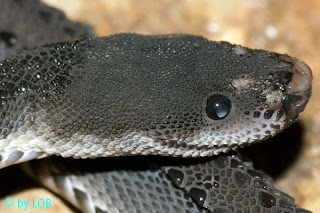This post will soon be available in Spanish!
 |
| Head of Xenodermus javanicus |
One of the weirdest-looking snakes in the world is Xenodermus javanicus, also called the Javan Tubercle Snake, Javan Mudsnake, Rough-backed Litter Snake, or, best of all, the Dragonsnake. Although they don't breathe fire, their anatomy is strange enough to evoke images of mythical creatures. The first Dragonsnake was described in 1836 by Danish zoologist Johannes T. Reinhardt. He named it Xenodermus, Greek for "foreign skin", because of its peculiar scales, of which Reinhardt described three types. A triple row of large keeled scales runs down the center of the back, flanked by two rows of huge keeled tubercles that resemble crests more than scales. The gaps between these knobby rows are covered in small irregular smooth diamond- and pentagon-shaped scales, whereas the space below the tubercles is coated in more traditional parallel rows of keeled dorsal scales, which nevertheless resemble a highly organized bed of oysters more than typical colubrid scalation.
 |
| Dorsal scales of Xenodermus javanicus |
Given the dorsal side only, it's difficult to tell what the taxonomic relationships of Dragonsnakes are. However, you can tell this snake is a colubroid if you examine the ventral side, where wide, well-developed ventral scales are present, unlike the smaller ventral scales of more primitive snakes. The tail, which constitutes up to a third of the total length, has a single row of scales on the underside, a characteristic reminiscent of vipers but also found in some colubroids. Overall, the head is probably the weirdest attribute. The top, sides, and bottom of the head are covered by small granular scales, similar to those of pythons and other henophidians. But a few specialized scales grace the nose and lips of Dragonsnakes. These include about 20 labial scales, a small rostral scale at the tip of the nose (impossible to see from above), two large nasal scales, directed forward, enclosing the nostrils, and several small shields in the vicinity of these nasal scales, separated by bare skin. What are all these weird scales for? Why didn't Dragonsnakes evolve more specialized scales, like the other descendants of their common ancestor with colubrids? These are open questions, but the Dragonsnake's environment probably has something to do with it. Another rare Bornean reptile, the Earless Monitor Lizard (Lanthanotus borneensis), has a similar mixture of high- and low-entropy scalation.
 |
| Ventral side of Xenodermus javanicus |
Dragonsnakes' closest relatives are 16 species of obscure snakes in 4 genera that together make up the family Xenodermatidae. Xenodermatids occupy a position similar to that of pareatids, near the base of the colubroid family tree. Traditionally, both xenodermatids and pareatids were considered subfamilies of the "junk family" Colubridae, but recent phylogenetic analyses all agree that they are only distantly related to other Colubridae, and must therefore be recognized as separate families. Xenodermatids are the most distantly related colubroids, or the "sister group" to all other colubroids, having diverged nearly 50 million years ago at the beginning of the Cenozoic, four times closer to the extinction of the dinosaurs than to today.
 |
| Xenodermus javanicus |
 |
| Dragonsnake plate from Dumeril's Erpetologie Generale, showing in detail the scale anatomy. This plate hangs on the wall in my dining room. |
ACKNOWLEDGMENTS
Thanks to Tom Charlton, Mister Pupkin, and LOB for use of their photographs.
REFERENCES
de Rooij, N. (1917) The Reptiles of the Indo-Australian Archipelago. Il. Ophidia. Leiden: E. J. Brill <link>
Kopstein, F. 1938. Ein beitrag zur morphologie, biologie, und ökologie von Xenodermus javanicus Reinhardt. Bulletin of the Raffles Museum 14:168-174. <link>
Reinhardt, J. T. 1836. Afhandling om Xenodermus javanicus. Oversigt over det Kongelige Danske videnskabernes selskabs forhandlinger. Kjobenhavn 3: 6-7 <link>